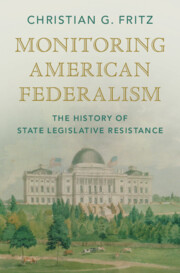Book contents
- Monitoring American Federalism
- Studies in Legal History
- Monitoring American Federalism
- Copyright page
- Dedication
- Contents
- Acknowledgments
- Introduction
- 1 The Riddle of Federalism and the Genesis of Interposition
- 2 Early State Use of Interposition: Testing the Powers of the New National Government
- 3 State Interposition and Debates over the Meaning of the Constitution
- 4 The Virginia and Kentucky Resolutions and Madison’s Report of 1800
- 5 State Interposition during the Jefferson and Madison Presidencies
- 6 State Challenges to the Supreme Court’s Control over Constitutional Interpretation
- 7 The Transformation of Interposition: The Theory of Nullification Emerges
- 8 State Interposition and Nullification on the Path to Secession
- 9 State Interposition during and after the Civil War
- 10 Modern Interposition by States and “Nullification”
- Abbreviations
- Notes
- Selected Short Titles
- Index
8 - State Interposition and Nullification on the Path to Secession
Published online by Cambridge University Press: 05 January 2023
- Monitoring American Federalism
- Studies in Legal History
- Monitoring American Federalism
- Copyright page
- Dedication
- Contents
- Acknowledgments
- Introduction
- 1 The Riddle of Federalism and the Genesis of Interposition
- 2 Early State Use of Interposition: Testing the Powers of the New National Government
- 3 State Interposition and Debates over the Meaning of the Constitution
- 4 The Virginia and Kentucky Resolutions and Madison’s Report of 1800
- 5 State Interposition during the Jefferson and Madison Presidencies
- 6 State Challenges to the Supreme Court’s Control over Constitutional Interpretation
- 7 The Transformation of Interposition: The Theory of Nullification Emerges
- 8 State Interposition and Nullification on the Path to Secession
- 9 State Interposition during and after the Civil War
- 10 Modern Interposition by States and “Nullification”
- Abbreviations
- Notes
- Selected Short Titles
- Index
Summary
President Andrew Jackson’s Proclamation of 1832 rejected the South Carolina Ordinance of Nullification and rejected secession as a constitutional right. South Carolina’s legislature passed a Counter-Proclamation that citizens of states owed their chief allegiance to their sovereign state and not the national government and were duty-bound to maintain sovereign states’ rights. Increasingly, Americans failed to find common ground in their understanding of constitutional history. Enforcement of the Constitution’s Fugitive Slave Clause generated important Supreme Court cases such as Prigg v. Pennsylvania (1842) and Ableman v. Booth (1859) as Southern states sought to enforce the Slave Clause through federal legislation such as the Fugitive Slave Act of 1850. Northern states responded by passing personal liberty laws to resist the enforcement of federal laws that would extend the authority of enslavers beyond the South. Southern states considered these personal liberty laws a nullification of federal law and as intended to eradicate slavery. The Kansas–Nebraska Act of 1854 and the election of Abraham Lincoln in 1860 moved the nation beyond interposition towards secession and civil war.
Keywords
- Type
- Chapter
- Information
- Monitoring American FederalismThe History of State Legislative Resistance, pp. 227 - 256Publisher: Cambridge University PressPrint publication year: 2023

